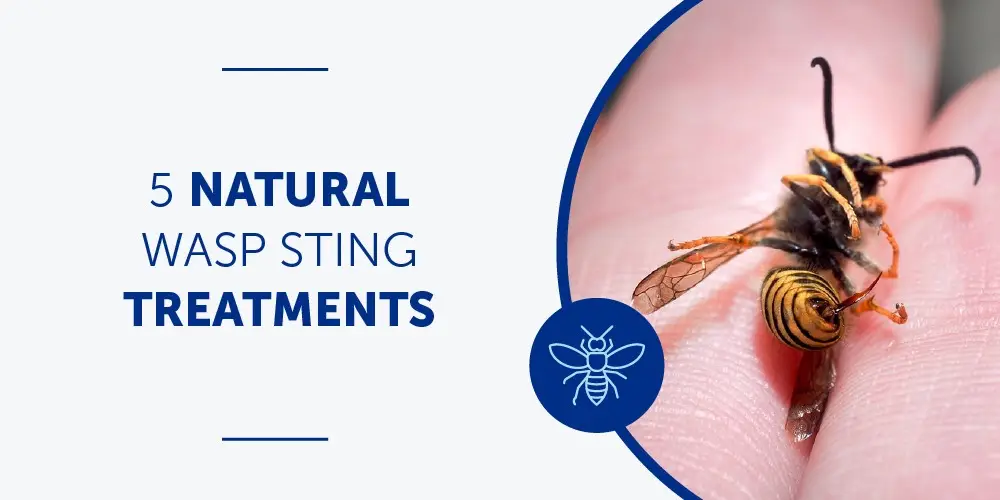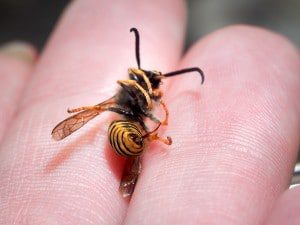Compared to bees, wasps are more hot tempered as they are a predatory flying insect. Therefore, they should be treated with caution. If you start seeing them swarming in and around your home or yard, it is likely they have a nest in your attic or somewhere in your garden.
While you take steps to find the source and rid your property of them, you are at risk of being stung. In case this happens, we’ve put together some natural wasp sting treatments to help with the pain and lower the risk of infection.
Before using any home remedy for a wasp sting, follow these first aid steps to reduce pain and swelling:
What to Do Immediately After a Wasp Sting
- Clean the area with mild soap and water.
- Apply a cold compress or wrapped ice pack for 10–15 minutes.
- Elevate the limb if the sting is on an arm or leg.
- Wasps typically do not leave a stinger behind, unlike bees. If you're unsure, gently inspect the site, but in most cases, there’s nothing to remove.
Read: How to get Rid of Wasps
5 Natural Remedies to Treat Wasp Stings at Home
- Ice: Ice numbs the pain and slows blood flow, reducing swelling. For best results, apply to the wasp sting area for 20 minutes. This is a simple yet effective wasp sting treatment.

- Vinegar: The vinegar will neutralize the venom from the wasp sting. Soak the wound for at least 15 minutes. The acidity in the vinegar will also absorb through the skin to eliminate pain and discomfort. A remedy for wasp sting that’s both effective and accessible.
- Honey: Ironically, applying raw or pure honey to the affected area lowers the risk of infection from a sting because of its antibacterial nature. Honey also helps with what to put on a wasp sting to soothe and heal.
- Lavender essential oil: Its antiseptic and anti-inflammatory properties will help heal the affected area. Lavender essential oil for wasp sting is also known for its calming properties and will help relieve the shock of a wasp sting.
- Plantain: Although we’re all about eliminating weeds at Bug & Weed Mart, this broad leaf weed, which you’ll find sprouting around in most of the Valley’s neighborhoods is an effective wasp sting home remedy treatment. If you opt to use this for treating the sting, you will need to release the juices from the leaves. When the juice is released, press it against the sting and cover with a moist cloth for 30 minutes or so.
Home Remedies to Treat Wasp Stings
| Treatment | Benefit | Use |
| Ice | Ice numbs the pain and slows blood flow, reducing swelling. | Apply ice wrapped in a cloth for about 20 minutes |
| Vinegar | Neutralizes venom and reduces pain and discomfort. The acidity helps absorb through the skin. | Soak a cloth in vinegar and place it on the sting for about 15 minutes. |
| Honey | Its antibacterial properties lower the risk of infection. | Apply a thin layer of raw honey directly to the sting. |
| Lavender Essential Oil | Has antiseptic and anti-inflammatory properties, helping to heal the affected area. Also calms the sting. | Dab a few drops of lavender oil on the sting to reduce pain and inflammation. |
| Plantain | This weed common in Arizona is known to help soothe the sting and reduce swelling. | Crush fresh leaves, squeeze out the juice, and press onto the sting under a damp cloth for 30 minutes. |
What Not to Do After a Wasp Sting
- Don’t scratch the sting area – It increases the risk of infection and irritation.
- Avoid using ice directly on the skin – Always wrap ice in a cloth to prevent frostbite.
- Don’t delay treatment – Early care reduces swelling and discomfort.
- Don’t rely solely on outdated home remedies – Stick to first-aid basics and tested solutions.
Read: The Most Dangerous Summer Pests in Arizona
If you believe you are allergic to wasps, it is imperative that you seek medical attention immediately after a sting.
To stay safe, seek bug & weed mart professional advice before removing a nest from your property. Unfortunately, this is not a recommended D.I.Y. task and it really requires a pest control expert in Arizona.
However, Bug & Weed Mart does sell effective products that allow you to kill wasps from a safe distance, so come in to any of our Valley-wide stores to see how we can help you with wasp bite treatment, wasp sting prevention, and removing a wasp nest from your home.


